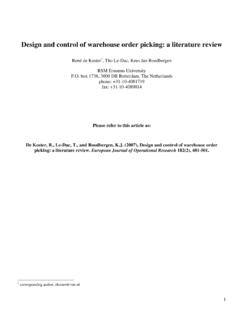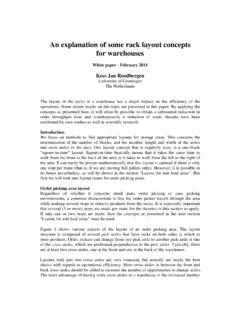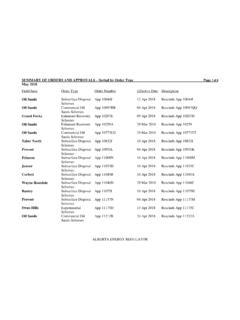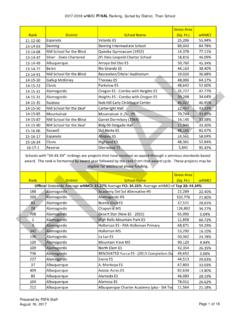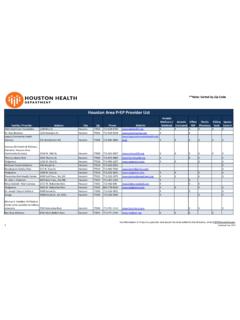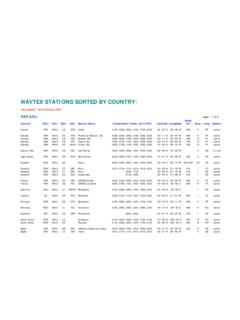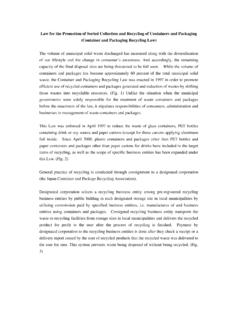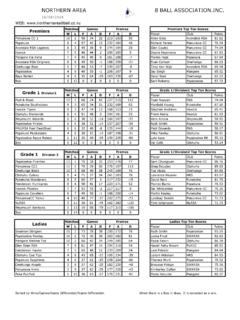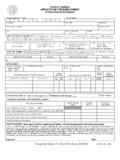Transcription of A model for warehouse layout - Roodbergen
1 a model for warehouse layout KEES JAN ROODBERGEN1, and IRIS VIS2. 1 RSM Erasmus University, box 1738, 3000 DR Rotterdam, The Netherlands 2 Vrije Universiteit Amsterdam, Faculty of Economics and Business Administration, De Boele- laan 1105, Room 3A-31, 1081 HV Amsterdam, The Netherlands Please refer to this article as: Roodbergen , and Vis, (2006), a model for warehouse layout . IIE Transactions 38(10), 799-811. Abstract This paper describes an approach to determine a layout for the order picking area in warehouses, such that the average travel distance for the order pickers is minimized. We give analytical formulas by which the average length of an order picking route can be calculated for two di erent routing policies. The optimal layout can be determined by using such formula as an objective function in a non-linear programming model . The optimal number of aisles in an order picking area appears to depend strongly on the required storage space and the pick list size.
2 1 Introduction Order picking is the process by which products are retrieved from storage to satisfy customer demand. In its simplest form, an order arrives at the warehouse and an order picker is sent into the picking area with the customer's list to retrieve the requested items from storage. Much research has been done to find methods to retrieve products from storage as e ciently as possible. The high e orts in this area are partly caused by the fact that order picking is an extremely expensive activity. Typically, the order picking contributes most to the operational costs of a warehouse (Tompkins et al., 2003). For the time required to pick an order, we can roughly distinguish three components: traveling between items, picking of items and remaining activities. Picking the items consists of a series of actions ranging from positioning the vehicle to putting the picked items on a product carrier.
3 The remaining activities include picking up an empty pick carrier, the acquisition of information, and dropping o the full pick carrier at some point after picking is complete. Most e orts to improve the operational e ciency of order picking can be categorized into three groups of operating policies, namely routing, batching, and storage assignment. Each of these approaches generally focuses on reducing travel times since these are easiest to influence. The time required for picking and remaining activities is influenced by aspects such as the chosen rack type and training of personnel. Routing concerns the traveling of the order picker from location to location to retrieve prod- ucts. Usually, a large part of an order picker's time is spent on traveling. Therefore this is an important aspect to consider. Research has focused on developing and comparing various routing methods.
4 For example, Petersen (1997) gives a number of routing methods for ware- houses with a ladder-structure, a warehouse with a number of parallel aisles where order pickers can change aisles in the front and rear cross aisle of the warehouse . Cross aisles are aisles perpendicular to the pick aisles and can be used to change from one aisle to the next. Rout- ing methods vary from simple heuristics to optimization schemes using dynamic programming. Two frequently used heuristics will be used in this paper and are explained below. A dynamic . Corresponding author 1. programming approach for routing in a warehouses with an added cross aisle in the middle is given in Roodbergen and De Koster (2001). With batching several orders or partial orders are combined to create one or more picking routes. One form is to aggregate all available orders and to pick each product type individually.
5 Another form is to combine several complete orders into one picking route. Numerous interme- diate forms exist. Much research is performed in this area , especially on methods that combine complete orders into a single route, see De Koster et al. (1999b) or Ruben and Jacobs (1999). If an order picker retrieves several orders at the same time, there are two possibilities: either the products are sorted by order while picking (sort-while-pick ) or the order integrity is restored after picking is completed (pick-and-sort). For sort-while-pick a special vehicle may be required to separate the various orders. For pick-and-sort a manual or automated sorting system may be needed. A situation where multiple pickers work on the same order can be found in areas with zoning, where each order picker only picks those products from an order that are located in his assigned part of the warehouse .
6 Research concerning storage assignment focuses mainly on rules to assign products to loca- tions. Existing rules range from random, where new storage locations are assigned to products randomly, to full-turnover storage, where products with the highest pick frequency are assigned to the easiest accessible locations. Intermediate forms also exist, such as ABC-storage, where the A, B, and C categories are determined based on pick frequencies but storage within the categories is random (see Petersen and Schmenner, 1999). A common objective for order-picking systems is to maximize the service level subject to resource constraints such as labor, machines, and capital. The service level is composed of a variety of factors such as response time, order integrity, and accuracy. A crucial link between order picking and service level is that the faster an order can be retrieved, the sooner it is available for shipping to the customer.
7 If an order misses its shipping due time, it may have to wait until the next shipping period. Also, short order retrieval times imply high flexibility in handling late changes in orders. Minimizing the order retrieval time (or picking time) is, therefore, a need for any order-picking system. Possible improvements by changing the operating policies are restricted by the physical layout of the area . That is, given a certain layout of the picking area , a good mix of operating policies can be chosen. In this paper, we will take the reverse approach. We propose a method that can find a layout that optimizes the order picking e ciency, given certain operating policies. Such a method allows designers to take operational e ciency factors into account while designing the warehouse . Specifically, we formulate a non-linear programming model to optimize the layout with respect to average travel distances.
8 In Section 2 we describe a model to find the best layout in a picking area consisting of one block. In Section 3 estimates are developed for the average travel distance of two common routing policies. In Section 4 the location of the depot is discussed. In Section 5 the results from the travel distance estimates are compared with simulation and with existing estimates from the literature. Section 6 describes some layout experiments. layout di erences resulting from the optimization with di erent routing policies are analyzed in Section 7. Conclusions are given in Section 8. 2 A model for layout optimization We consider a manual order picking operation, where order pickers walk or drive through a picking area to retrieve products from storage. Picked items are placed on a vehicle, which the order picker takes with him on his route. With some minor changes, we can also optimize other picking environments with this model , see Section The picking area is rectangular with no 2.
9 Unused space and consists of a number of parallel aisles. At the front and rear of the picking area there is a cross aisle to enable aisle changes. An example of a layout of such a picking area is given in Fig. 1. Solid black squares in the figure indicate sections in the rack where items have to be picked. Order pickers are assumed to be able to traverse an aisle in either direction and to change direction within an aisle. Items are stored on both sides of the aisles. Item locations are deter- mined randomly according to a uniform distribution. We consider this storage assignment policy because it can be considered as a base-line against which layouts with other storage assignment policies can be compared. Furthermore, random storage is frequently used in practice. This occurs, for example, in situations where the product assortment changes too fast to produce reliable statistics about demand frequency (see De Koster et al.)
10 , 1999a). Previous work on travel distance estimation for random storage is described in Hall (1993). Estimations in an activity based storage environment are described in for example Caron et al. (1998) and Chew and Tang (1999). Each order consists of a number of items, which can and will be picked in a single route (such a "pick order" can be the result of a batching procedure, though). Picked orders have to be deposited at the depot, where the picker also receives the instructions for the next route. The depot is located in the front cross aisle. We use two routing policies called the S-shape (or traversal) policy and the largest gap policy. These policies are widely used in practice (see Hall, 1993). With the S-shape policy, any aisle containing at least one item is traversed through the entire length. Aisles where nothing has to be picked are not entered. After picking the last item, the order picker returns to the front end of the aisle.

